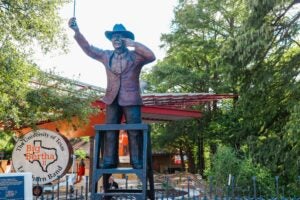AUSTIN, Texas–The School of Nursing at The University of Texas at Austin will be one of the first schools in the nation to offer a course on how to minister to victims of a mass casualty event when it offers "Disaster Nursing" beginning July 18.
The post-Sept. 11 look to the School of Nursing’s curriculum content starts with second-semester classes (July 15-Aug. 16).
"If a mass casualty event like those of Sept. 11 occurs in Austin or anywhere else in the state, nurses at every level will be called upon to employ emergency response skills," said Dolores Sands, dean of the School of Nursing. "Though nursing has had little training or experience with treating victims of weapons of mass destruction — we want our students to be ready."
Earlier this year, Sands was appointed to the International Nursing Coalition for Mass Casualty Education, a new coalition based at Vanderbilt University and composed of international nursing, medical, military and education experts. Members of the group began looking at how to change curriculum for current students and through continuing education.
In the university’s elective class, which is open to undergraduate and graduate students, the structure and organization of health management in disaster response will be taught. The summer class will be held every Thursday from 8:30 a.m. to 5 p.m.
Students will learn everything from how to decontaminate victims at an incident site to how to recognize and treat the psychological impact of a mass casualty event on victims and health care professionals. After the course, they also will able to perform effective triage, appropriately handle human remains, transport victims and complete recovery operations, including reports and debriefings.
"We developed this course as a direct response to the events of Sept. 11," said Dr. Marilyn Pattillo, who will teach the course. "We always have taught public health nursing, emergency room nursing, etc., but now it’s a whole new ballgame."
Not only will nurses be at the forefront of treating victims of a mass casualty disaster, they could the first respondents in a biological terror event "because we see the rash first," said Pattillo.
"Nurses are everywhere — in schools, in public health, hospitals, offices, industries and businesses — and we need to know what to do," she said. "If a mass casualty event occurs, every nurse should be available to employ emergency response skills."
Learning how to deal with the psychological impact of terrorist strike is particularly important, said Pattillo.
"A bioterrorism event is different from all other forms of terrorism because of its potential to create panic and civic disorder," she said.
Pattillo has lined up numerous speakers for the course, including a terrorism officer from the National Emergency Response and Rescue Training Center, the director of emergency management for the city of Austin, a member of the Federal Bureau of Investigation, the head of the emergency preparedness division of the Texas Department of Health and various experts on bioterrorism. Bill Coll, director of medical operations with the Austin Fire Department, also will speak.
There will be a mock disaster response drill July 25 in the quadrangle of the nursing school. Students, wearing protective clothing, will be simulating a patient extraction from a contaminated site. There also will be stations set up to highlight the role of the nurse in preventing responder stress and safety. On Aug. 1, students will learn how to splint, dress and wound and treat eye injuries during a standard first-aid session.
"Like most disaster concepts, this course is divided into three areas — preparedness, response and recovery," said Pattillo, who is retired from the U.S. Air Force Reserve Nurse Corps and is active in American Red Cross disaster health services.
As students learn from other disciplines, the speakers also will be learning from nursing, Pattillo said. "So, there actually will be a two-way learning effort going on."
For further information contact: Nancy Neff, 512-471-6504.



